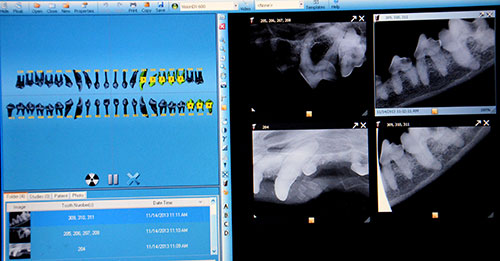A Healthy Pet Has a Healthy Mouth
Dental disease in dogs and cats is one of the most common problems we encounter in the clinic. It’s estimated that up to 85 percent of all dogs and cats over three years of age have some degree of periodontal disease (not just tartar, but more serious problems with the structures that support the teeth).
Consequences of Neglected Teeth
You may have heard that a dog’s mouth is cleaner than a human’s. While that depends largely on where that mouth has been lately, a dog’s mouth is always a pretty dirty place, and that goes for cats, too! Saliva, food debris, and bacteria accumulate on the teeth to form plaque. Left undisturbed, plaque rapidly becomes “mineralized” or hardened into calculus (tartar). Substances secreted by the bacteria in plaque contribute to inflammation and infection around and under the gums that can lead to decay, painful abscesses (localized infections), tooth loss, and even infection in other parts of the body, such as the kidneys, liver, and heart.
Taking care of your pet’s teeth is about much more than avoiding bad breath. The consequences of neglected teeth can range from unpleasant to severe including:
- Pain (from minor discomfort to massive toothache)
- Difficulty eating
- Inflammation of the gums and/or bone
- Loss of teeth
- Infection spreading to heart valves, kidneys, and/or liver
- Shortened lifespan
When Does Your Pet Need Dental Treatment?
Until dental disease is severe, many pets do not show any signs of discomfort. This is why we recommend annual oral exams and wellness checkups. However, you should make an appointment if you notice any of the following signs:
- Bad breath (if persistent or extremely bad)
- Brown plaque on teeth
- Red or swollen gums
- Gums that bleed easily
- Excessive salivation
- Loose teeth
- Reluctance to pick up toys with the mouth, hesitating to chew, or chewing only on one side
What Does Dental Treatment Involve?

Because awake pets will not allow the necessary extensive examination of the mouth, proper dental treatment requires general anesthesia. We remove the tartar from your pet’s teeth using dental instruments and an ultrasonic cleaning device. We visually inspect and physically probe the teeth for fractures, chips, and other abnormalities; then we carefully evaluate the health of the gums and their attachments to the teeth.
Radiographs (x-rays) may be needed to assess what’s going on around and under the teeth and bones. Then, depending on what we find, dental treatment can range from a simple cleaning and polishing to more extensive treatments. It is sometimes necessary to extract damaged or decayed teeth. This is far preferable to leaving a tooth that is or is likely to become painful, loose, or infected. Antibiotics and pain medications may be needed before and after dental treatment.
We do not recommend anesthesia-free dental cleaning
There are a number of reason why we do not recommend this procedure. Anesthesia-free dental cleaning is considered “unacceptable and below the standard of care” by the American Animal Hospital Association, which sets 900 standards of excellence that accredited veterinary hospitals must meet to ensure the highest quality of veterinary care is being delivered.
Performing dental cleanings on awake animals subjects them to stress, increases risks of tissue trauma from sharp instruments, increases risks of aspiration of aerosolized plaque and tartar, and provides a false sense of security because the teeth are “clean”, but pathology such as cavities and periodontal pockets have not been identified. If a pet has a cavity or other potentially painful oral lesion, awake cleanings are likely to be very painful to that patient.
In addition, periodontal disease (disease of the attachments of the teeth) is a disease that occurs up under the gumline and can only be identified with dental x-rays and treated in a “still” patient under anesthesia. The best way to clean teeth, identify problem areas and treat them or find ways to prevent them from getting worse is with a thorough oral exam and cleaning under anesthesia.
At-Home Prevention and Care

It is important to understand that no matter what you do at home, plaque can still build up under the gumline where even a toothbrush cannot reach, and this is where the real problems begin. However, there are several things you can do to help keep your pet’s mouth healthy and avoid extensive dental treatment.
- Daily tooth brushing for dog and cats can prevent plaque from hardening into tartar, a process that occurs in just 24-48 hours; always use toothpaste made for pets, not people
- Feeding specially formulated foods and treats designed to prevent dental problems
- Providing appropriate chew toys for dogs and cats
- Feeding abrasive dental chews
- Using commercial preventatives such as VetzLife, Plaque Off or CET Oral Rinse.
- Bringing your pet in for regular check-ups
Our staff is here to help you. We are happy to make specific recommendations for your pet to keep your pet’s mouth fresh and clean.
